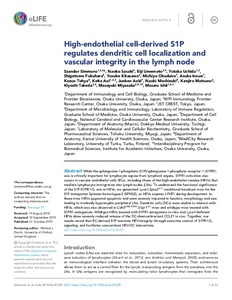High-endothelial cell-derived S1P regulates dendritic cell localization and vascular integrity in the lymph node
Simmons S; Sasaki N; Umemoto E; Uchida Y; Fukuhara S; Kitazawa Y; Okudaira M; Inoue A; Tohya K; Aoi K; Aoki J; Mochizuki N; Matsuno K; Takeda K; Miyasaka M; Ishii M
High-endothelial cell-derived S1P regulates dendritic cell localization and vascular integrity in the lymph node
Simmons S
Sasaki N
Umemoto E
Uchida Y
Fukuhara S
Kitazawa Y
Okudaira M
Inoue A
Tohya K
Aoi K
Aoki J
Mochizuki N
Matsuno K
Takeda K
Miyasaka M
Ishii M
eLife Sciences Publications Ltd
Julkaisun pysyvä osoite on:
https://urn.fi/URN:NBN:fi-fe2021042824499
https://urn.fi/URN:NBN:fi-fe2021042824499
Tiivistelmä
While the sphingosine-1-phosphate (S1P)/sphingosine-1-phosphate
receptor-1 (S1PR1) axis is critically important for lymphocyte egress
from lymphoid organs, S1PR1-activation also occurs in vascular
endothelial cells (ECs), including those of the high-endothelial venules
(HEVs) that mediate lymphocyte immigration into lymph nodes (LNs). To
understand the functional significance of the S1P/S1PR1-Gi axis in HEVs, we generated Lyve1;Spns2Δ/Δ
conditional knockout mice for the S1P-transporter Spinster-homologue-2
(SPNS2), as HEVs express LYVE1 during development. In these mice HEVs
appeared apoptotic and were severely impaired in function, morphology
and size; leading to markedly hypotrophic peripheral LNs. Dendritic
cells (DCs) were unable to interact with HEVs, which was also observed
in Cdh5CRE-ERT2;S1pr1Δ/Δ mice and wildtype mice treated with S1PR1-antagonists. Wildtype HEVs treated with S1PR1-antagonists in vitro and Lyve1-deficient
HEVs show severely reduced release of the DC-chemoattractant CCL21 in
vivo. Together, our results reveal that EC-derived S1P warrants
HEV-integrity through autocrine control of S1PR1-Gi signaling, and facilitates concomitant HEV-DC interactions.
receptor-1 (S1PR1) axis is critically important for lymphocyte egress
from lymphoid organs, S1PR1-activation also occurs in vascular
endothelial cells (ECs), including those of the high-endothelial venules
(HEVs) that mediate lymphocyte immigration into lymph nodes (LNs). To
understand the functional significance of the S1P/S1PR1-Gi axis in HEVs, we generated Lyve1;Spns2Δ/Δ
conditional knockout mice for the S1P-transporter Spinster-homologue-2
(SPNS2), as HEVs express LYVE1 during development. In these mice HEVs
appeared apoptotic and were severely impaired in function, morphology
and size; leading to markedly hypotrophic peripheral LNs. Dendritic
cells (DCs) were unable to interact with HEVs, which was also observed
in Cdh5CRE-ERT2;S1pr1Δ/Δ mice and wildtype mice treated with S1PR1-antagonists. Wildtype HEVs treated with S1PR1-antagonists in vitro and Lyve1-deficient
HEVs show severely reduced release of the DC-chemoattractant CCL21 in
vivo. Together, our results reveal that EC-derived S1P warrants
HEV-integrity through autocrine control of S1PR1-Gi signaling, and facilitates concomitant HEV-DC interactions.
Kokoelmat
- Rinnakkaistallenteet [27094]
